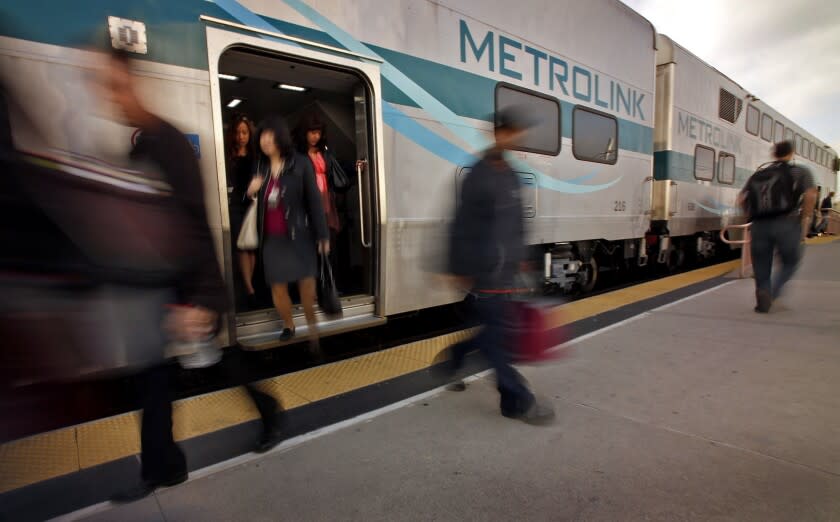Metrolink system would stop trains during earthquakes

If you use Metrolink for getting around Southern California, your trip may have just got a little safer during an earthquake.
The transportation rail system announced this week it is equipping some of its trains with a new earthquake warning system that can automatically slow or halt travel during a temblor.
The first trains to receive the new technology are on Metrolink’s 91/Perris Valley Line between Riverside and Perris. That route was selected because of its relatively low ridership as well as its proximity to several major fault lines, officials said.
Metrolink plans to roll out the system to all trains along its 538-mile rail system, which runs across six counties.
"It's one additional thing in their toolbox that helps Metrolink protect their riders and train crew," said Robert-Michael de Groot, a spokesperson for the U.S. Geological Survey's ShakeAlert system.
A previous system implemented in September sent notifications based on ShakeAlert data to Metrolink engineers operating a train during an earthquake.
Under the new system, if an earthquake is expected to shake strong enough, automated technology will kick in and slow the train or bring it to a complete stop.
Before last year, Metrolink relied on a game of telephone, in which dispatchers would get an alert about a quake's magnitude and location and then manually relay that to train engineers, said Luis Carrasquero, Metrolink's interim deputy chief operating officer.
That system was used after the 7.1 magnitude quake centered in Ridgecrest that shook Southern California on Fourth of July weekend in 2019. Metrolink shut down its service that day as it inspected the line for damage.
"With earthquake alert warning, time is the basic currency," de Groot said. "Machines can act much faster than people."
Automated braking systems are not new for Metrolink. They were added to trains after a 2008 collision in Chatsworth in which 25 people were killed when the engineer of a commuter train was distracted and ran head-on into a Union Pacific freight.
The new system combines the automated brakes with ShakeAlert's warnings.
And a machine will take control only if the shaking is intense enough.
Using what is called the Modified Mercalli Intensity scale, the system will send notifications to train engineers when shaking during a quake is weak or light, similar to that of a passing truck and observable by someone inside the train, Carrasquero said.
When shaking builds toward the level of being awakened at night, or when windows and doors begin to rattle, the system will automatically reduce the train's speed.
If shaking is intense enough to break windows, dump dishes from cabinets and topple unstable objects, the system will bring the train to a halt.
The USGS also will send Metrolink a report on which parts of the railway, bridge, overpass or tunnel may be damaged so that crews can inspect those areas before resuming travel, Carrasquero said. The automated system will avoid stopping a train beneath any of those compromised structures.
De Groot said Metrolink's new system also has importance for a region's resilience and recovery after a serious quake.
"You need trains and highways to get people out and first responders to where they need to go," de Groot said. "And one of the key paths to recovery is to have your transportation lines open so that you could get supplies to people."
After the Northridge earthquake in 1994 damaged major freeways, including the 10, the 5 and Highway 14, transit officials added more train and buses, including Metrolink routes to and from Santa Clarita, to alleviate transportation needs.
Although the earthquake alert system eventually will make its way onto all Metrolink-owned railways, its trains also operate on tracks owned by other companies. Metrolink owns about 60% of its rails lines, while the remaining 40% are owned by Union Pacific, BNSF Railway and the North County Transit District.
If during a quake a Metrolink train is traveling on another company's tracks, the system will send warnings and notifications to train engineers, but it will not slow or stop the train.
Since the initial warning system was added to Perris Valley trains last year, no earthquakes significant enough to activate it have struck, Carrasquero said.
After several months of testing the system on its Perris Valley trains, Metrolink will begin to add it to nearby lines.
Since 2020, Bay Area Rapid Transit in Northern California has used a similar automated ShakeAlert technology that halts or slows trains.
The Los Angeles County Metropolitan Transportation Authority also uses ShakeAlert warnings to notify its staff, rail operators and maintenance crews of quakes, but it does not have an automated breaking system.
Much like many public transportation systems, Metrolink ridership has dipped since the COVID-19 pandemic began in spring 2020. Before then, average daily weekday ridership was 45,000, said Karen Bakar, a spokesperson for Metrolink. Last month, the average daily ridership was only about 15,000.
This story originally appeared in Los Angeles Times.

